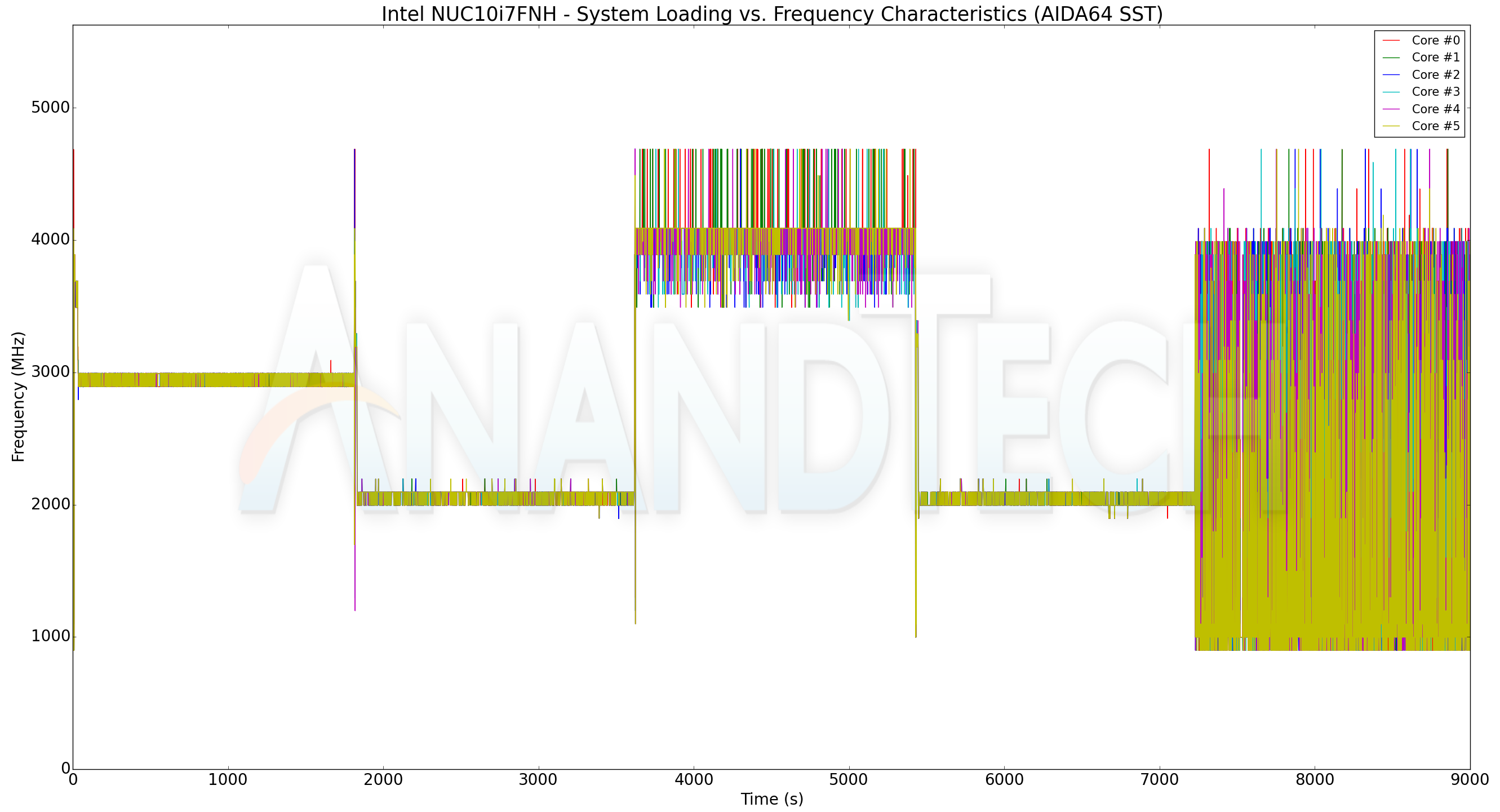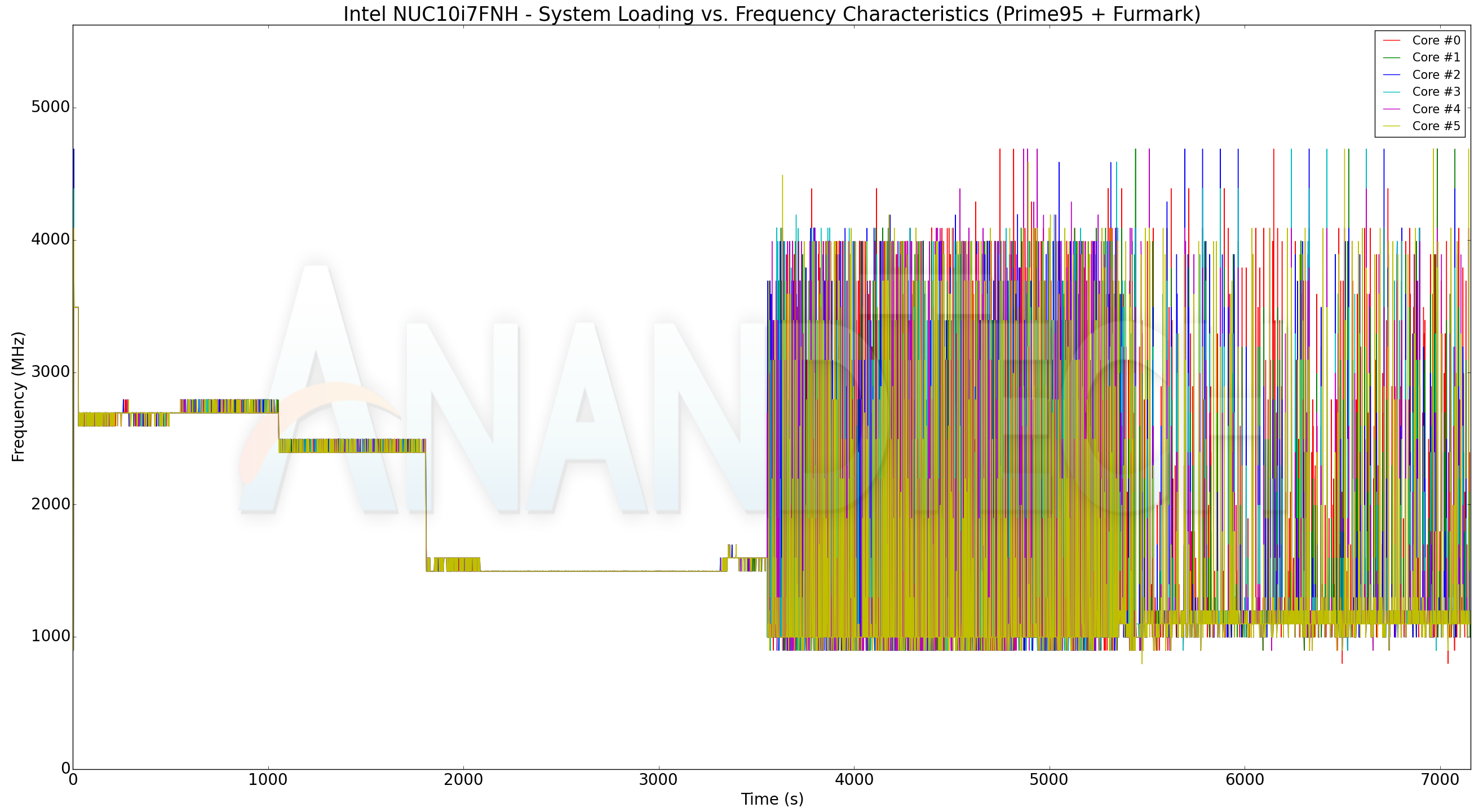Intel NUC10i7FNH Frost Canyon Review: Hexa-Core NUC Delivers a Mixed Bag
by Ganesh T S on March 2, 2020 9:00 AM ESTPower Consumption and Thermal Performance
The power consumption at the wall was measured with a 4K display being driven through the HDMI port. In the graphs below, we compare the idle and load power of the Intel NUC10i7FNH (Frost Canyon) with other low power PCs evaluated before. For load power consumption, we ran the AIDA64 System Stability Test with various stress components, and noted the maximum sustained power consumption at the wall.

The usage of a PCIe 3.0 x2 NVMe SSD along with a low TDP processor (25W, compared to the 28W+ processors in the other systems, other than the June Canyon NUC) manufactured in a highly-optimized and power-efficient 14nm process result in the Frost Canyon NUC having a sub-5W idle power consumption even while driving a 4K display. The system is able to sustain 90W+ at the wall for a very brief duration only, with the power falling slightly south of 60W for sustained workloads.
Our thermal stress routine starts with the system at idle, followed by four stages of different system loading profiles using the AIDA64 System Stability Test (each of 30 minutes duration). In the first stage, we stress the CPU, caches and RAM. In the second stage, we add the GPU to the above list. In the third stage, we stress the GPU standalone. In the final stage, we stress all the system components (including the disks). Beyond this, we leave the unit idle in order to determine how quickly the various temperatures in the system can come back to normal idling range. The various clocks, temperatures and power consumption numbers for the system during the above routine are presented in the graphs below.
| Intel NUC10i7FNH (Frost Canyon) System Loading with the AIDA64 System Stability Test | |||

The frequencies adjust to ensure that the 30W PL1 is maintained. With just the CPU loaded, the cores can maintain around 3 GHz sustained. Adding the GPU brings the CPU cores down to 2 GHz. With only the GPU stressed, the CPU cores can stay close to their boost clocks without consuming much power. The thermal design is quite good, with the package temperature never above 90C for extended durations.
| Intel NUC10i7FNH (Frost Canyon) System Loading with Prime95 and Furmark | |||

Our custom stress test with Prime95 and Furmark shows similar characteristics. Frequencies get adjusted to maintain a 30W package power, and the package temperature does not cross 85C. Furmark loads the GPU more than the AIDA stress component, and hence, we see the CPU frequency drop down to around 1.5 GHz in this case.










85 Comments
View All Comments
ganeshts - Monday, March 2, 2020 - link
Has been discussed ad-nauseam.If you don't like Bapco's SYSmark, feel free to skip the section.
We believe it presents credible comparison points because it uses *publicly available builds of commercially used software*. The same Adobe applications and MS Office applications are going to be used by consumers whether they have an Intel-based machine or an AMD-based machine.
FWIW, the Frost Canyon numbers in SYSmark actually show that there is no major gains in the benchmark to be had with the addition of the two cores compared to Bean Canyon. Whether people like it or not, most real-world applications fall back on single-threaded performance - Here, Bean Canyon and Frost Canyon are essentially neck-to-neck.
Irata - Tuesday, March 3, 2020 - link
I know this has been discussed a lot, but isn‘t the consensus that it cannot be used as it‘s essentially an Intel sponsored benchmark. I mean nVidia, AMD and Via pulled out for a reason.Also, they have a history of skewing results by stressing certain tasks that feature specific CPU architectures over others going back to the P4 days. Why should this be different now?
James5mith - Monday, March 2, 2020 - link
I have 64GB of RAM in my Bean Canyon NUC running VM's right now. How is this the first one to support it?ganeshts - Monday, March 2, 2020 - link
The keyword is 'officially supported'Max Memory Size is 32GB on this page: https://ark.intel.com/content/www/us/en/ark/produc...
MDD1963 - Monday, March 2, 2020 - link
Pg 1 "... is stil a bit of an unsteady eara" Eara? :)Zok - Tuesday, March 3, 2020 - link
Ugh. Come on! Give me a NUC with 2+ NICs.snowsurferDS - Tuesday, March 3, 2020 - link
The AsRock mini 300 should be tested with a 3400G not a 2400G, at least.dontlistentome - Tuesday, March 3, 2020 - link
Prices keep on going up for no reason (seriously, why should this be so much more epensive than the i7s of a few years ago?).And that power consumption? 64W peak.
next gen the power brick will be bigger than the NUC box.
alpha754293 - Tuesday, March 3, 2020 - link
It's too bad that the thermal management design on these systems are so bad that under heavy CPU and/or CPU+GPU load, it's runs very quickly against the thermal limit, and therefore; has to start throttling itself due to the thermals.If the system had a better thermal management solution and was ACTUALLY able to run at full load for extended period of time, in this form factor, then it would be worth it, else, having a 6-core processor in there is so pointless since you can't even make full use of the previous 4-core CPU in the NUC8.
This is my biggest complaint about my two NUC8s that I have. If it had better thermal management so it wouldn't throttle itself due to thermals, it would present a compelling argument against, for example, the Mac Mini.
ROD.LEE - Tuesday, March 3, 2020 - link
was thinking of upgrading from my NUC8I7BEK, after your review, umm no.